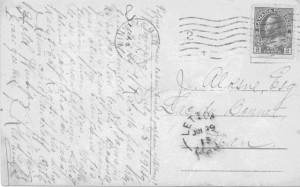
Latvian men in Boston USA 1908 - John Ulman, John Beckman and the Belgin brothers came to Lettonia soon after. ~ photo courtesy of Vivian Nespar
Latvia is a country in the Baltic region of northern Europe. About 1905 there was a failed revolution to over throw the land owners or German Barons by the Latvians to regain control of their own schools and activities. Consequently several thousand Latvians escaped persecution by fleeing to freedom in North America or South America. At that time Brazil, the United States, and Canada were advertising golden lands of opportunity and free homesteads.
The Latvians migrated to Manitoba from Brazil and the United States. Latvian families took up homesteads in Libau, Lettonia, Newcombe, Lee River, Bird River, and Sifton areas from the early 1900’s to the 1930’s.
Homesteads on the river were acquired “sight unseen” due to the lack of roads and the fact that the river was the only way of transportation. It is amazing how one would have to paddle 25 miles into the wilderness to locate their quarter section of land on the Bird River.

Bird River homesteaders August 15, 1921 - Back row: Ed Peterson, Willis Gulbis, John Ledin, Mikel Osis, George Drawson Sr. Front Row: Lapin Greikst, and Peter Preede. ~ photo courtesy of R.E. Emmett
The homesteaders had to clear land, build a house, and live on the land at least part of the year. Most had to work away for a portion of the year on threshing, trapping, prospecting, laboring at Pointe du Bois, Pinawa Dam, and Lac du Bonnet Brick Works, cutting wood or other jobs.
As an example of the amount of cord wood cut between 1912 and 1920, one mile East of Lee River F. Hestrin & Sons were shipping out 5 or 6 boxcar loads a week. They had 1 thousand cords stacked up awaiting available box cars to ship to Winnipeg at one time.
Newcombe and Lettonia are approximately 10 - 18 miles NE of the village of Lac du Bonnet. This area was settled primarily of Latvians with a sprinkling of Swedes and Norwegians. Lettonia means Latvia or land of the Letts in French. Lettonia was born when the post office was opened in 1913 with John Alksne as first postmaster. John Alksne also donated a portion of his homestead for the Lettonia cemetery.
Eventually small mixed farming commenced, raising cattle, pigs, chickens, sheep, turkeys, and some dairy and fur farming of fox and mink began.

John Peterson’s water powered sawmill at the junction of Bird River and Peterson Creek. ~ photo courtesy of Trethart
John Peterson built a saw mill at the junction of Peterson creek and Bird River that supplied lumber for the surrounding homes. Newcombe school was built in 1915 near Lettonia, Bird River and Lee River school construction followed in 1919 -1920.
John and Annie Mathews donated a piece of land jetting out into the water, not far from their home, where Lettonia Hall was built in the 1920’s. This hall was the centre of activities for people from Bird River, Lee River, and Newcombe for socials, bazaars, plays, dances, and Christmas concerts. A community hall was also built at Lee River.

Lee River Hall with kitchen portion removed. From the 20s to the 50s it was the popular spot for weddings, dances, socials, and get-togethers. ~ photo courtesy of Ves Zarins
This hall was a 12 mile sleigh ride from Bird River and had a polished wood floor, a stage at one end, and a kitchen at the other with a balcony overlooking the dance floor below.
Latvians contributed greatly to mineral exploration and the discovery of copper, chromite, and other minerals north of the Winnipeg River in the 1920s to 30s especially Bernic Lake and Bissett areas.
About 1951 their lands were expropriated by Manitoba Hydro for the building of the McArthur Dam for bay. Homes and barns were moved or demolished. The waters were raised 5 meters or 16 feet with a vast portion of Lettonia, Newcombe, Lee River, and Bird River disappearing beneath the waters.
Looking at the Lac du Bonnet District museum 2014 display you can capture our Latvian heritage through photos and artifacts and understand the impact Latvians had in this area. The names Libau, Lettonia, Grausdin Point, Gulbis lake , Osis lake, Anson lake, Sarapu lake, and Lapin Lake bear testament to our Latvian homesteaders.

